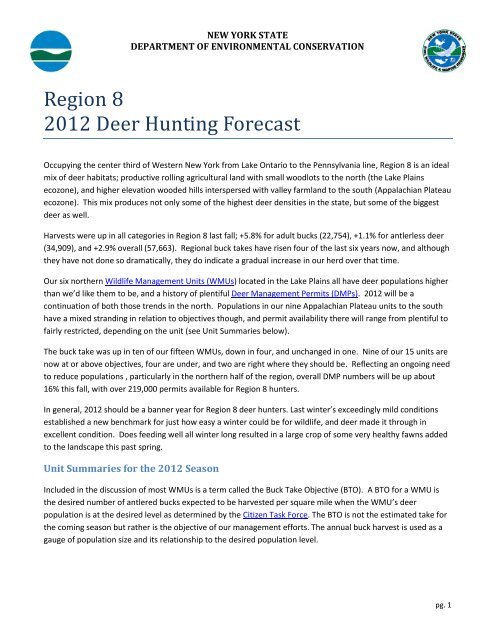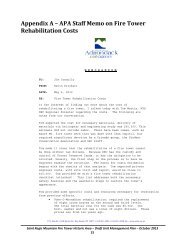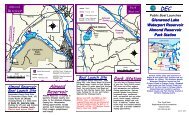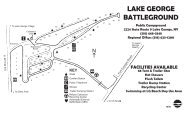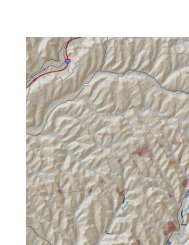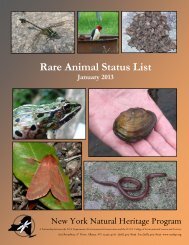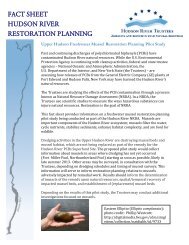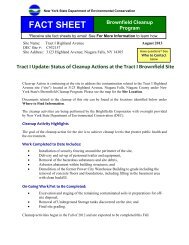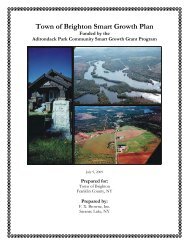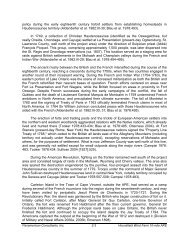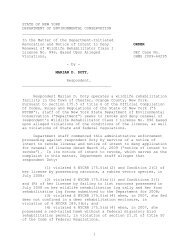Region 8 - New York State Department of Environmental Conservation
Region 8 - New York State Department of Environmental Conservation
Region 8 - New York State Department of Environmental Conservation
You also want an ePaper? Increase the reach of your titles
YUMPU automatically turns print PDFs into web optimized ePapers that Google loves.
NEW YORK STATE<br />
DEPARTMENT OF ENVIRONMENTAL CONSERVATION<br />
<strong>Region</strong> 8<br />
2012 Deer Hunting Forecast<br />
Occupying the center third <strong>of</strong> Western <strong>New</strong> <strong>York</strong> from Lake Ontario to the Pennsylvania line, <strong>Region</strong> 8 is an ideal<br />
mix <strong>of</strong> deer habitats; productive rolling agricultural land with small woodlots to the north (the Lake Plains<br />
ecozone), and higher elevation wooded hills interspersed with valley farmland to the south (Appalachian Plateau<br />
ecozone). This mix produces not only some <strong>of</strong> the highest deer densities in the state, but some <strong>of</strong> the biggest<br />
deer as well.<br />
Harvests were up in all categories in <strong>Region</strong> 8 last fall; +5.8% for adult bucks (22,754), +1.1% for antlerless deer<br />
(34,909), and +2.9% overall (57,663). <strong>Region</strong>al buck takes have risen four <strong>of</strong> the last six years now, and although<br />
they have not done so dramatically, they do indicate a gradual increase in our herd over that time.<br />
Our six northern Wildlife Management Units (WMUs) located in the Lake Plains all have deer populations higher<br />
than we’d like them to be, and a history <strong>of</strong> plentiful Deer Management Permits (DMPs). 2012 will be a<br />
continuation <strong>of</strong> both those trends in the north. Populations in our nine Appalachian Plateau units to the south<br />
have a mixed stranding in relation to objectives though, and permit availability there will range from plentiful to<br />
fairly restricted, depending on the unit (see Unit Summaries below).<br />
The buck take was up in ten <strong>of</strong> our fifteen WMUs, down in four, and unchanged in one. Nine <strong>of</strong> our 15 units are<br />
now at or above objectives, four are under, and two are right where they should be. Reflecting an ongoing need<br />
to reduce populations , particularly in the northern half <strong>of</strong> the region, overall DMP numbers will be up about<br />
16% this fall, with over 219,000 permits available for <strong>Region</strong> 8 hunters.<br />
In general, 2012 should be a banner year for <strong>Region</strong> 8 deer hunters. Last winter’s exceedingly mild conditions<br />
established a new benchmark for just how easy a winter could be for wildlife, and deer made it through in<br />
excellent condition. Does feeding well all winter long resulted in a large crop <strong>of</strong> some very healthy fawns added<br />
to the landscape this past spring.<br />
Unit Summaries for the 2012 Season<br />
Included in the discussion <strong>of</strong> most WMUs is a term called the Buck Take Objective (BTO). A BTO for a WMU is<br />
the desired number <strong>of</strong> antlered bucks expected to be harvested per square mile when the WMU’s deer<br />
population is at the desired level as determined by the Citizen Task Force. The BTO is not the estimated take for<br />
the coming season but rather is the objective <strong>of</strong> our management efforts. The annual buck harvest is used as a<br />
gauge <strong>of</strong> population size and its relationship to the desired population level.<br />
pg. 1
WMU 8A<br />
Area = 419 mile 2<br />
BTO = 2.1 bucks harvested per mile 2<br />
2011 Buck Take = 2.6 bucks harvested per mile 2<br />
2011Total Deer Take = 7.2 deer harvested per mile 2<br />
WMU 8A is situated primarily in northern Orleans and<br />
Monroe Counties and contains very little public land.<br />
The terrain is mostly flat to gently rolling and has an<br />
abundance <strong>of</strong> agriculture interspersed with small<br />
woodlots, making for excellent habitat and large deer.<br />
The buck take didn’t move at all last fall, staying at 2.6<br />
bucks per square mile. The population remains above the objective, where it has been for some time. A record<br />
doe harvest in 2010 may send the buck take down some this fall, but it won’t be by much, and hunters will<br />
scarcely notice a change in the number <strong>of</strong> deer they see in the woods. Permit availability will be identical to last<br />
year; HIGH for both first and second permits for all applicant categories, including non-residents.<br />
WMU 8C<br />
Area = 138 mile 2<br />
BTO = None<br />
2011Buck Take = 0.9 bucks harvested per mile 2<br />
2011Total Deer Take = 2.1 deer harvested per mile 2<br />
WMU 8C is a small "bowhunting only" unit<br />
surrounding the City <strong>of</strong> Rochester in Monroe County<br />
and has historically harbored a high deer population<br />
relative to the associated human development. Deer<br />
harvest here is governed largely by land access, not<br />
number <strong>of</strong> permits available, and there is no shortage<br />
<strong>of</strong> deer for those willing to hunt the fringes <strong>of</strong> “suburbia”. If desired, anyone applying for a DMP should receive<br />
two permits. Chances <strong>of</strong> success remain high in 8C, but because hunting access is limited, applicants are advised<br />
to secure a hunting location before applying for DMPs. It is also a good idea to check local ordinances regarding<br />
the discharge <strong>of</strong> bows. Note also that deer hunters in this unit must have passed a Bowhunter Education course,<br />
and the only legal hunting implement, for all big game seasons, is bow and arrow. To assist in reducing the<br />
growth <strong>of</strong> this deer population, Bonus Permits will be available for hunters who fill their WMU 8C DMPs. Those<br />
hunters taking antlerless deer on Bonus Permits may continue to receive additional Bonus Permits as long as<br />
they continue to be used to harvest antlerless deer. Chances <strong>of</strong> selection this fall will be high for residents and<br />
nonresidents on both first and second permits.<br />
pg. 2
WMU 8F<br />
Area = 733 mile 2<br />
BTO = 2.0 bucks harvested per mile 2<br />
2011 Buck Take = 3.3 bucks harvested per mile 2<br />
2011 Total Deer Take = 9.2 deer harvested per mile 2<br />
WMU 8F occupies most <strong>of</strong> Wayne and a portion <strong>of</strong><br />
Monroe County and contains a good deal <strong>of</strong><br />
agriculture, including significant orchard acreage. The<br />
lay <strong>of</strong> the land is flat to rolling in the north with<br />
numerous drumlins (glacially carved hills) in the<br />
south. Large wetlands and significant forest cover<br />
exist, particularly in the northeast portion <strong>of</strong> the unit. There is ample public hunting land in eastern 8F. The buck<br />
take last fall in 8F shot up 14% to 3.3 bucks per square mile, and represents an historic high for the unit. The<br />
highest doe harvest on record two years ago should temper population growth some, but not nearly enough to<br />
bring this unit’s deer population down to objective. A positive historical relationship between DMPs issued and<br />
DMP harvest suggests that increasing permit numbers is a logical choice in this unit; such a relationship is not<br />
always the case in all units. Chances <strong>of</strong> selection this fall will be high for residents and nonresidents on both first<br />
and second permits.<br />
WMU 8G<br />
Area = 686 mile 2<br />
BTO = 2.3 bucks harvested per mile 2<br />
2011 Buck Take = 3.6 bucks harvested per mile 2<br />
2011 Total Deer Take = 10.7 deer harvested per mile 2<br />
WMU 8G comprises most <strong>of</strong> Genesee County and the<br />
southern portion <strong>of</strong> Orleans County. It contains a<br />
large expanse <strong>of</strong> state and federal land in the western<br />
part <strong>of</strong> the unit. This unit has some <strong>of</strong> the region's<br />
best agricultural land, and the deer habitat here is<br />
among the most productive in the state. Land is flat to gently rolling, with small wood lots interspersed with<br />
farms and wetlands. Buck harvest rose two tenths last fall, to a new unit record <strong>of</strong> 3.6 per square mile. Suffice<br />
to say, this population is still above the harvest objective <strong>of</strong> 2.3 bucks per square mile. A record doe harvest in<br />
2010 should temper growth, but don’t look for there to be noticeably less deer when on stand this fall; changes<br />
will be slight, if any. A record number <strong>of</strong> DMPs will be available for 8G hunters this fall, and chances <strong>of</strong> receiving<br />
first and second permits will be high for all categories <strong>of</strong> applicants.<br />
WMU 8H<br />
Area = 574 mile 2<br />
BTO = 2.8 bucks harvested per mile 2<br />
2011 Buck Take = 4.3 bucks harvested per mile 2<br />
2011 Total Deer Take = 13.0 deer harvested per mile 2<br />
WMU 8H includes parts <strong>of</strong> Livingston, Monroe, and<br />
Ontario Counties and has limited public land<br />
pg. 3
accessible for hunting. This is another typical Lake Plains unit; in other words, an ideal mix <strong>of</strong> habitat with big<br />
healthy deer and a productive population that has resisted our efforts at herd reduction. The buck harvest in 8H<br />
rose once again last year, and now stands at 4.3, over 50% above objective. Three years now <strong>of</strong> ever-increasing<br />
doe takes, capped with last fall’s record number, should begin to stop the expansion, if not by this fall, then by<br />
2013. 8H has super deer habitat, with plenty <strong>of</strong> agriculture, and it is proving to be, like many <strong>of</strong> its surrounding<br />
Lake Plains units, a difficult area to reign in the deer population. Deer hunting will be great in 8H this fall. A<br />
record number <strong>of</strong> DMPs will be available, with chances <strong>of</strong> selection high on first and second permits for all<br />
categories <strong>of</strong> applicants.<br />
WMU 8J<br />
Area = 712 mile 2<br />
BTO = 2.1 bucks harvested per mile 2<br />
2011 Buck Take = 3.0 bucks harvested per mile 2<br />
2011 Total Deer Take = 7.9 deer harvested per mile 2<br />
WMU 8J includes portions <strong>of</strong> Seneca, Wayne, Ontario,<br />
and Yates Counties, and a moderate amount <strong>of</strong> public<br />
hunting land available. A lot <strong>of</strong> agriculture exists here,<br />
and WMU 8J has a history <strong>of</strong> producing big healthy<br />
deer with some <strong>of</strong> the biggest antler beam diameters<br />
in the region. The buck take has risen three straight years now in 8J, and now stands at 3.0 per square mile,<br />
some 43% above the objective <strong>of</strong> 2.1. In response, we’ll <strong>of</strong>fer even more DMPs than we did last year, but, like<br />
most <strong>of</strong> our northern units, it will be an uphill battle finding enough hunters to fill them. Hunters can expect<br />
there to be plenty <strong>of</strong> deer in 8J this fall, and hunting prospects will be excellent. Almost 25,000 permits will be<br />
available for 8J deer hunters this fall, and chances <strong>of</strong> selection will be high for both resident and nonresident<br />
applicants in all categories.<br />
WMU 8M<br />
Area = 307 mile 2<br />
BTO = 3.9 bucks harvested per mile 2<br />
2011 Buck Take = 3.5 bucks harvested per mile 2<br />
2011 Total Deer Take = 8.2 deer harvested per mile 2<br />
WMU 8M is situated primarily within southern<br />
Livingston County and holds plenty <strong>of</strong> public land. A<br />
transitional unit between our Lake Plains and<br />
Southern Tier ecozones, there is both open<br />
agricultural land to the north and higher, wooded hills<br />
to the south. Even though the buck take went down slightly last fall, to 3.5 per square mile, the trend since<br />
2005’s low point has been gradually up. From a biologist’s perspective, this slow, steady upward movement<br />
toward objective is preferable to wide population swings, as it lends more stability and predictability to our<br />
management. We have every reason to believe 8M will be very close to our population objective within the<br />
next few years. A relatively low doe harvest in 2010 should allow the population to take a tick up this season,<br />
but changes in the woods will be hard to notice, and hunters can expect a similar year to last. Chances <strong>of</strong> DMP<br />
selection will be high for residents seeking first permits, but there will be no second permits or permits for<br />
nonresidents this year.<br />
pg. 4
WMU 8N<br />
Area = 314 mile 2<br />
BTO = 4.6 bucks harvested per mile 2<br />
2011 Buck Take = 5.9 bucks harvested per mile 2<br />
2011 Total Deer Take = 16.4 deer harvested per mile 2<br />
WMU 8N includes southern Ontario and portions <strong>of</strong><br />
Livingston and Yates Counties. Many diverse public<br />
hunting opportunities exist in this largely wooded and<br />
hilly Western Finger Lakes unit. After several years <strong>of</strong><br />
buck takes near the objective <strong>of</strong> 4.6 per square mile,<br />
the 8N deer population is once again on the move,<br />
and in a big way. Last fall’s buck harvest (an index to<br />
the overall population) shot from 5.0 up to 5.9 per square mile, an almost unprecedented one year increase for<br />
a WMU. This is <strong>of</strong> great concern to us, as 8N has a history <strong>of</strong> quick expansions. Returning to the kind <strong>of</strong> buck<br />
takes we saw ten years ago (7 to 8 bucks per square mile) would be a step back for the diversity <strong>of</strong> vegetation in<br />
the unit, as well as for folks trying to make their living growing things there. The good news is that hunters will<br />
see more deer in the woods this fall. From a management perspective, the down side is that a relatively low doe<br />
harvest two years ago will allow the deer population in 8N to go even higher in 2013. We need to take as many<br />
deer as we legally can in this unit, and do it now. Chances <strong>of</strong> permit selection this fall will be high for both<br />
resident and nonresident applicants in all categories.<br />
WMU 8P<br />
Area = 356 mile 2<br />
BTO = 4.2 bucks harvested per mile 2<br />
2011 Buck Take = 3.4 bucks harvested per mile 2<br />
2011 Total Deer Take = 5.9 deer harvested per mile 2<br />
WMU 8P is located in northern Steuben County and<br />
contains a fair amount <strong>of</strong> public land. The terrain is<br />
rolling to hilly, and the unit sports a balanced mix <strong>of</strong><br />
both farm land and forest. The buck take in 8P came<br />
up a little last fall, to 3.4 per square mile (indicating a<br />
slightly increasing population), but the unit is still well below the objective, as it has been since 2004. Doe<br />
harvests the last two years were very low, and we could be looking at noticeably more deer on the landscape by<br />
2013 as a result. But the unit has been fairly unresponsive to relatively low adult female harvests before, so our<br />
current recourse is to keep DMP numbers low again this year. Chances <strong>of</strong> selection will be high on first permits<br />
for residents only. No other permits will be available.<br />
pg. 5
WMU 8R<br />
Area = 270 mile 2<br />
BTO = 4.2 bucks harvested per mile 2<br />
2011 Buck Take = 5.7 bucks harvested per mile 2<br />
2011 Total Deer Take = 17.2 deer harvested per mile 2<br />
WMU 8R includes most <strong>of</strong> Yates County, as well as<br />
parts <strong>of</strong> Steuben and Schuyler Counties, and has a fair<br />
amount <strong>of</strong> public hunting land. Large rolling hills<br />
predominate, with an ample amount <strong>of</strong> farmland in<br />
the valleys and hill tops, including significant vineyard<br />
acreage. After a four-year stretch near objective in<br />
the mid 2000s, the buck take has now risen five straight years, and currently stands at 5.7 per square mile, up<br />
from 5.2 last year. A very aggressive female harvest in 2010 should help put the brakes on population<br />
expansion, but this unit has shown the ability for quick growth, and like 8N, is on the verge <strong>of</strong> getting out <strong>of</strong><br />
hand. We will need to put continued high pressure on the female segment <strong>of</strong> the herd in the coming years. We<br />
anticipate the buck take to be similar to last year, or a little higher, which means hunters will continue to see lots<br />
<strong>of</strong> deer in the fields and woods <strong>of</strong> 8R. Chances <strong>of</strong> DMP selection will be high for residents and nonresidents on<br />
both first and second permits.<br />
WMU 8S<br />
Area = 256 mile 2<br />
BTO = 2.8 bucks harvested per mile 2<br />
2011Buck Take = 3.4 bucks harvested per mile 2<br />
2011Total Deer Take = 7.1 deer harvested per mile 2<br />
WMU 8S includes portions <strong>of</strong> Schuyler and Seneca<br />
Counties and is home to the Finger Lakes National<br />
Forest, a large tract <strong>of</strong> federal land open to hunting.<br />
Agriculture is the main land use in this unit except in<br />
the southwest where the public land is located.<br />
Topography is flat in most <strong>of</strong> the unit except for the southwest corner. A lowering <strong>of</strong> this unit’s BTO in 2009 from<br />
4.2 to 2.8 has meant that for the last two years, we have been slightly over objective in 8S, after a lengthy<br />
stretch below. The buck take stayed steady last fall at 3.4 per square mile, indicating a stable population, even if<br />
it is a little over the objective <strong>of</strong> 2.8. We are currently employing a mild reducing strategy in the unit in an effort<br />
to bring down the buck take to objective level. This means there will be marginally more permits available this<br />
fall, but not drastically so. Hunters in 8S should expect to see similar numbers <strong>of</strong> deer this fall. Chances <strong>of</strong><br />
selection will be high on first permits for both residents and non-residents. The availability <strong>of</strong> second permits<br />
for residents will be low. No second permits for non-residents will be available.<br />
pg. 6
WMU 8T<br />
Area = 385 mile 2<br />
BTO = 4.8 bucks harvested per mile 2<br />
2011 Buck Take = 3.7 bucks harvested per mile 2<br />
2011 Total Deer Take = 7.4 deer harvested per mile 2<br />
WMU 8T is in central Steuben County and has ample<br />
public hunting land available. It is a typical southern<br />
tier unit in that it is hilly, with a mix <strong>of</strong> agriculture in<br />
the valleys, and forested slopes. This unit has not<br />
been above the buck harvest objective since 2002<br />
despite at least eight years <strong>of</strong> fairly low doe harvests.<br />
A reduction in female take in 2010, and again last year should, in theory, allow the population to come up, but<br />
8T has been very resistant to our efforts to grow deer numbers. Hunters here can expect similar deer sightings<br />
as last year, or perhaps a few more. This fall, permit availability will be at its lowest point since 2005 to try and<br />
induce some change. Chances <strong>of</strong> selection this year will be low on first permits for residents only. No other<br />
permits will be available.<br />
WMU 8W<br />
Area = 439 mile 2<br />
BTO = 3.8 bucks harvested per mile 2<br />
2011 Buck Take = 3.2 bucks harvested per mile 2<br />
2011 Total Deer Take = 5.8 deer harvested per mile 2<br />
WMU 8W includes portions <strong>of</strong> Chemung and Schuyler<br />
Counties and holds abundant public hunting<br />
opportunities. 8W is one <strong>of</strong> our most forested units,<br />
but open farmland does exist, particularly in the north<br />
and east portions <strong>of</strong> the unit. The buck take in WMU<br />
8W has been below objective since 2003, but is showing signs lately <strong>of</strong> upward movement. Buck take per square<br />
mile rose three tenths last fall, up to 3.2, on top <strong>of</strong> a similar increase seen in 2010. We anticipate buck take will<br />
go up again this fall, making three straight years if our predictions are correct. Our strategy here is to keep<br />
DMPs (and thus doe harvest) relatively low, to foster the upward trend we are seeing. Hunters in 8W may see a<br />
few more deer in the woods this fall, but increases will likely not be dramatic. Chances <strong>of</strong> first permit selection<br />
will be high for residents, but non-residents will require preference points. No second permits will be available.<br />
WMU 8X<br />
Area = 401 mile 2<br />
BTO = 4.1 bucks harvested per mile 2<br />
2011 Buck Take = 4.0 bucks harvested per mile 2<br />
2011 Total Deer Take = 10.0 deer harvested per mile 2<br />
WMU 8X is located in southern Steuben County and<br />
has a fair amount <strong>of</strong> public land available. The unit is<br />
hilly, with its highest elevations and most forest cover<br />
in the northern portion. A good deal <strong>of</strong> farm land<br />
pg. 7
occurs in the southern valleys, particularly along portions <strong>of</strong> the <strong>New</strong> <strong>York</strong>-Pennsylvania border. Holding the<br />
current situation stable is the order <strong>of</strong> the day in 8X as we have been very close to our population goal now for<br />
the last three years. Buck take per square mile came down two tenths last fall, but it is still right about where<br />
we want it to be, indicating a stable population. Since the population is where it should be, our strategy is to<br />
maintain the doe harvests seen the last few years. Hunters in 8X should expect to see similar numbers <strong>of</strong> deer<br />
this fall. Chances <strong>of</strong> DMP selection will be high on first permits for both residents and nonresidents, but<br />
preference points will be required for resident second permits. No second permits will be available for<br />
nonresidents.<br />
WMU 8Y<br />
Area = 354 mile 2<br />
BTO = 4.5 bucks harvested per mile 2<br />
2011 Buck Take = 3.7 bucks harvested per mile 2<br />
2011 Total Deer Take = 7.2 deer harvested per mile 2<br />
WMU 8Y occupies the southern half <strong>of</strong> Chemung and<br />
a small portion <strong>of</strong> Steuben County and has very<br />
limited public hunting opportunities. It is another <strong>of</strong><br />
our most heavily forested units, but also contains the<br />
relatively large cities <strong>of</strong> Corning and Elmira. 8W has<br />
spent a good number <strong>of</strong> years below objective now, since 2003. The buck take has risen the last two years<br />
though, and we anticipate it will increase again this fall, but it won’t be up near objective just yet. As in any unit<br />
whose population is lower than desired, our strategy will simply be to hold DMPs relatively low until we see a<br />
response by way <strong>of</strong> increased buck harvest. Still, chances <strong>of</strong> selection will be high on first permits for both<br />
residents and non-residents. Chances on second permits for residents will be medium. No second permits will<br />
be available for non-residents.<br />
Art Kirsch<br />
<strong>Region</strong> 8 Deer Biologist<br />
pg. 8


